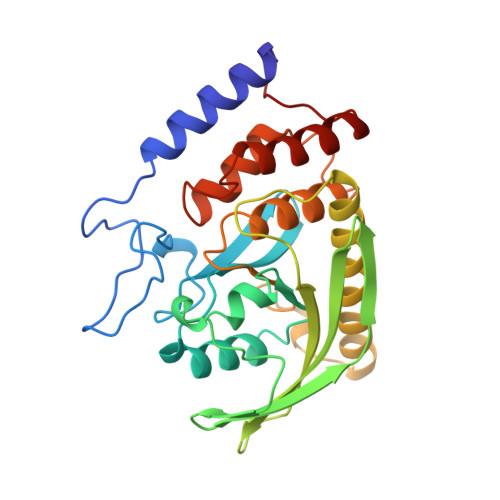A ligand-induced conformational change in the Yersinia protein tyrosine phosphatase.
Schubert, H.L., Fauman, E.B., Stuckey, J.A., Dixon, J.E., Saper, M.A.(1995) Protein Sci 4: 1904-1913
- PubMed: 8528087
- DOI: https://doi.org/10.1002/pro.5560040924
- Primary Citation of Related Structures:
1YTS - PubMed Abstract:
Protein tyrosine phosphatases (PTPases) play critical roles in the intracellular signal transduction pathways that regulate cell transformation, growth, and proliferation. The structures of several different PTPases have revealed a conserved active site architecture in which a phosphate-binding loop, together with an invariant arginine, cradle the phosphate of a phosphotyrosine substrate and poise it for nucleophilic attack by an invariant cysteine nucleophile. We previously reported that binding of tungstate to the Yop51 PTPase from Yersinia induced a loop conformational change that moved aspartic acid 356 into the active site, where it can function as a general acid. This is consistent with the aspartic acid donating a proton to the tyrosyl leaving group during the initial hydrolysis step. In this report, using a similar structure of the inactive Cys 403-->Ser mutant of the Yersinia PTPase complexed with sulfate, we detail the structural and functional details of this conformational change. In response to oxyanion binding, small perturbations occur in active site residues, especially Arg 409, and trigger the loop to close. Interestingly, the peptide bond following Asp 356 has flipped to ligate a buried, active site water molecule that also hydrogen bonds to the bound sulfate anion and two invariant glutamines. Loop closure also significantly decreases the solvent accessibility of the bound oxyanion and could effectively shield catalytic intermediates from phosphate acceptors other than water. We speculate that the intrinsic loop flexibility of different PTPases may be related to their catalytic rate and may play a role in the wide range of activities observed within this enzyme family.
Organizational Affiliation:
Biophysics Research Division, University of Michigan, Ann Arbor 48109-1055, USA.















